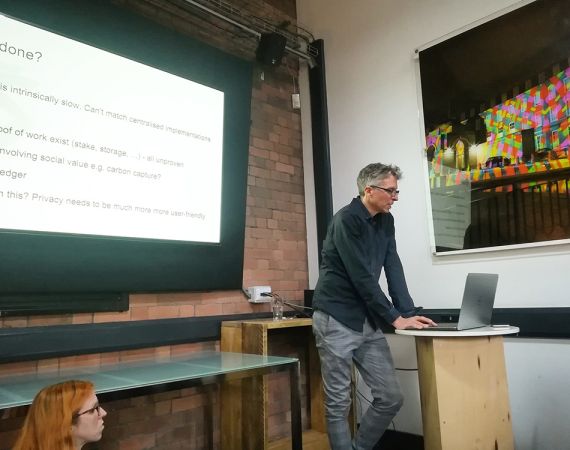Lunchtime talk write-up
Posted on Tue 23 Jan 2018
Blockchain for Sceptics
More people are aware of Bitcoin now than ever, but what exactly is it? Tim Kindberg reveals all...

Posted by
Speaker
More people are aware of Bitcoin now than ever, but what exactly is it? Tim Kindberg began the Lunchtime Talk by presenting a chart of the cryptocurrency prices since its creation all the way up to this morning and what was apparent was that Bitcoin is a highly volatile currency. However, Bitcoin and other cryptocurrencies are only one application of a process called Blockchain. Tim assured us the talk wasn’t going to be like the series of ‘For Dummies’ books that gets you to swallow new techs unquestioningly, but rather it will examine Blockchain through a sceptical lens.
Five Things I Learned:
1. Tim is interested how Bitcoin brings together technology, environment, economics and politics. Bitcoin entered the world in 2008 created by mysterious figure known as Satoshi Natamoto. The idea is Cryptocurrency replaces physical tokens/notes with bits and software, decentralising transactions. This means trusted third parties such as government or financial institutions are no longer necessary, creating low transaction fees and allowing for anonymity and pseudonymity (often users have a reputation without people knowing their identity).
2. If you look at a five-pound note, you’ll see it has a serial number and many intricate aspects that are hard to duplicate. Yet it is similar to cryptocurrency in that it has a value, but it also has no value at all. Tim shows us his very own fake digital currency ‘no coin’ to demonstrate the ‘double spending problem’. The trouble with digital currency compared with the fiver is that it can be copied easily over and over; this needs to be prevented with a ledger or a record of transactions. Traditionally methods of digital payment such as debit card transactions, companies such as Visa is the trusted third-party thats takes care of all the mechanics. For cryptocurrency, this is where Blockchain comes in.
3. Think of Blockchain as the digital equivalent of an indestructible physical ledger, written in permanent ink. Each block contains transactions in an order that can’t be changed, deleted or reordered. If someone were to tamper with it, it would be obvious as everything is cryptographically linked. An input of any length goes through a mathematical process which then creates outputs as sequence of letters in a fixed length, otherwise known as a ‘cryptographic hash function’. The ledger is public, but all the identifiers are anonymised. For the ledger to work everyone must converge on the same ledger in order to keeping the values the same. In order to do this a collection of miners co-operate, instead of centralised authority, by adding blocks of transactions to ledger.
4. This is known as Distributed Consensus. In order to make a block ‘miners’ are constantly adding blocks (new transactions) to a chain with the aim of creating the longest chain. ‘Mining’ or ‘miners’ refers to the extremely labour-some computing process of solving mathematical problems. Miners are rewarded in Bitcoin for solving extremely difficult puzzles and making chains, so everyone is trying to keep up in the race for the longest blockchain. Having tons of computing powerful is an advantage, but it is still possible to get lucky and ‘win the lottery’ to create the longest chain of blocks. This process is known as ‘proof of work’.
5. For all its appeal, Blockchain is not without its caveats. Significant computation is needed to mine a block and only one block is created every 10 minutes on average. If we compare transaction numbers, Visa’s average is 1,500 transactions per second while Bitcoin is just 5. Tim believes miners are most likely wealthy unidentified companies. According to recent research, the degree of decentralisation is low: just four miners account for over 50% of the total mining capacity. The impact mining has on the environment is great in terms of energy consumption. According to one researcher, Bitcoin is just behind Qatar in its level of energy consumption! The stability of the currency is another negative factor; Bitcoin’s price volatility is five to ten times higher than gold and other major currencies.
Tim isn’t going to be investing in Bitcoin or CryptoKitties anytime soon, but what he is interested in is the societal elements of the decentralised algorithm. It certainly suits an anti-authority, libertarian agenda – ‘payment and governance by the people’.

